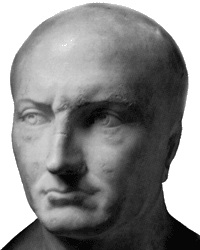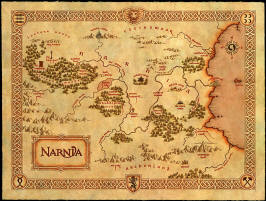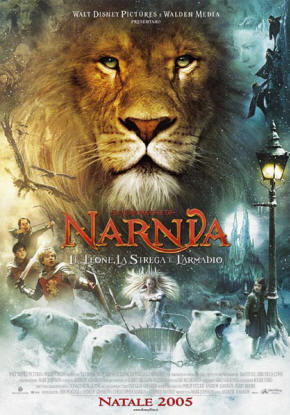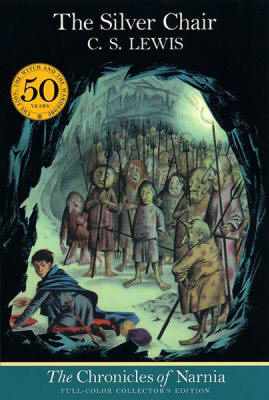|
| Le Cronache di Narnia |

Le Cronache di Narnia
The Chronicles of Narnia
(Le Monde de Narnia; Las Crnicas de Narnia; Die Chroniken von Narnia)
di Clive Staples Lewis
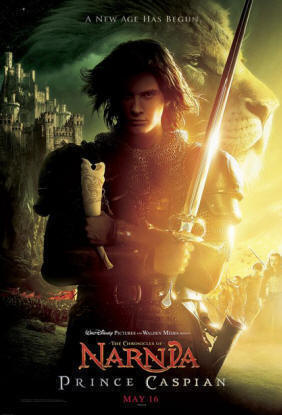
Locandina del film The Chronicles of Narnia - Prince Caspian
Il nuovo film della Disney"Le Cronache di Narnia - Il Principe Caspian"Prima mondiale il 26 maggio 2008:
|
|
Il ciclo delle Cronache di Narnia, sette romanzi pubblicati tra il 1950 e il 1956, lopera pi celebre dello scrittore irlandese Clive Staples Lewis (Belfast, 29 novembre 1898 - Oxford, 22 novembre 1963). Questi romanzi illustrano alcuni aspetti del cristianesimo, ma in essi i concetti teologici ben si fondono nel contesto narrativo, nel quale non mancano riferimenti alla mitologia celtica e romana e alle pi tradizionali fiabe per bambini.
La Mappa delle Terre di Narnia - Clicca sulla foto per vederla ingrandita
|
| I sette romanzi in ordine
di pubblicazione sono:
1950 - Il leone, la strega e l'armadio (The Lion, the Witch, and the Wardrobe) 1951 - Il principe Caspian (Prince Caspian) 1952 - Il viaggio del veliero (The Voyage of the Dawn Treader) 1953 - La sedia d'argento (The Silver Chair) 1954 - Il cavallo e il ragazzo (The Horse and His Boy) 1955 - Il nipote del mago (The Magician's Nephew) 1956 - L'ultima battaglia (The Last Battle)
I libri vennero riordinati dall'editore HarperCollins secondo l'ordine cronologico interno, come suggerito dal figliastro di C. S. Lewis, Douglas Gresham: 2 - Il leone, la strega e l'armadio
Links interessanti:
|
Il leone, la strega e l'armadioTitolo originale: The Lion, the Witch, and the Wardrobe (1950) (Francese: Le Lion, la Sorcire blanche et l'Armoire magique, tome 2; Spagnolo: El Len, la Bruja y el Ropero; Tedesco: Der Knig von Narnia) Incipit 1 Lucy entra nell'armadio C'erano una volta quattro bambini che si chiamavano Peter, Susan, Edmund e Lucy. Vivevano a Londra ma, durante la seconda guerra mondiale, furono costretti ad abbandonare la citt per via dei bombardamenti aerei. Furono mandati in casa di un vecchio professore che abitava nel cuore della campagna, a poco meno di venti chilometri dalla pi vicina stazione ferroviaria e a tre chilometri e mezzo dall'ufficio postale. Il professore non aveva moglie: alla casa badava la signora Macready, la governante, aiutata da tre cameriere che si chiamavano Ivy, Margaret e Betty (ma nella nostra storia c'entrano poco). ... Incipit in the original language LUCY LOOKS INTO A WARDROBE ONCE there were four children whose names were Peter, Susan, Edmund and Lucy. This story is about something that happened to them when they were sent away from London during the war because of the air-raids. They were sent to the house of an old Professor who lived in the heart of the country, ten miles from the nearest railway station and two miles from the nearest post office. He had no wife and he lived in a very large house with a housekeeper called Mrs Macready and three servants. (Their names were Ivy, Margaret and Betty, but they do not come into the story much.) ...
Il principe CaspianTitolo originale: Prince Caspian (1951) (Francese: Le Prince Caspian, tome 4; Spagnolo: El Prncipe Caspian; Tedesco: Prinz Kaspian von Narnia) Incipit 1 L'isola C'erano una volta quattro ragazzi che si chiamavano Peter, Susan, Edmund e Lucy. Nel libro intitolato Il leone, la strega e l'armadio si racconta una loro straordinaria avventura: un giorno, infatti, avevano aperto un armadio magico e si erano trovati in un mondo completamente diverso dal nostro. In quel mondo erano diventati re e regine di una terra chiamata Narnia. Durante il periodo trascorso a Narnia, i quattro ragazzi si erano convinti di aver regnato per anni e anni, ma quando, attraversando di nuovo l'armadio magico, erano tornati in Inghilterra, il tempo sembrava non essere affatto trascorso. In ogni caso nessuno aveva notato la loro assenza, e i ragazzi avevano raccontato la straordinaria avventura solo a un uomo di grande saggezza. Tutto questo avveniva soltanto un anno prima; adesso i quattro se ne stavano seduti sulla panchina di una stazione ferroviaria, con le scatole dei giocattoli e i bagagli ammucchiati accanto a loro, perch la scuola sarebbe iniziata tra poco. Avevano fatto il viaggio insieme fino alla stazione, che era infatti un nodo ferroviario. ... Incipit in the original language THE ISLAND ONCE there were four children whose names were Peter, Susan, Edmund, and Lucy, and it has been told in another book called The Lion, the Witch and the Wardrobe how they had a remarkable adventure. They had opened the door of a magic wardrobe and found themselves in a quite different world from ours, and in that different world they had become Kings and Queens in a country called Narnia. While they were in Narnia they seemed to reign for years and years; but when they came back through the door and found themselves in England again, it all seemed to have taken no time at all. At any rate, no one noticed that they had ever been away, and they never told anyone except one very wise grown-up. That had all happened a year ago, and now all four of them were sitting on a seat at a railway station with trunks and playboxes piled up round them. They were, in fact, on their way back to school. They had travelled together as far as this station, which was a junction... ...
Il viaggio del velieroTitolo originale: The Voyage of the Dawn Treader (1952) (Francese: L'Odysse du Passeur d'Aurore, tome 5; Spagnolo: La Travesa del Explorador del Amanecer [La travesa del Viajero del Alba]; Tedesco: Die Reise auf der Morgenrte) Incipit 1 Il quadro nella camera da letto C'era un ragazzo che si chiamava Eustachio Clarence Scrubb, e se lo meritava. I suoi genitori lo chiamavano Eustachio Clarence, i professori solo Scrubb; non so come lo chiamassero gli amici, visto che Eustachio Clarence non ne aveva. Quando si rivolgeva ai genitori, non li chiamava pap e mamma come qualsiasi altro figlio, ma Harold e Alberta. Erano entrambi persone di mondo e alla moda: non fumavano, non bevevano, erano vegetariani e, come se non bastasse, indossavano uno speciale tipo di biancheria intima. Vivevano in una casa con pochi mobili, dove era raro vedere abiti sparsi in giro o sui letti. Le finestre erano sempre spalancate. A Eustachio Clarence piacevano molto gli animali, in particolar modo gli scarafaggi, meglio se morti o infilzati con uno spillo sulle schede di cartone della sua collezione. Gli piacevano anche i libri, ma solo quelli zeppi di informazioni, con la fotografia di qualche strano congegno per riempire i granai o quella di qualche ragazzino cicciottello di altri paesi, con la testa china sui libri in una qualsiasi scuola modello. ... Incipit in the original language THE PICTURE IN THE BEDROOM THERE was a boy called Eustace Clarence Scrubb, and he almost deserved it. His parents called him Eustace Clarence and masters called him Scrubb. I can't tell you how his friends spoke to him, for he had none. He didn't call his Father and Mother "Father" and "Mother", but Harold and Alberta. They were very up-to-date and advanced people. They were vegetarians, non-smokers and teetotallers and wore a special kind of underclothes. In their house there was very little furniture and very few clothes on beds and the windows were always open. Eustace Clarence liked animals, especially beetles, if they were dead and pinned on a card. He liked books if they were books of information and had pictures of grain elevators or of fat foreign children doing exercises in model schools. ...
La sedia d'argentoTitolo originale: The Silver Chair (1953) (Francese: Le Fauteuil d'argent, tome 6; Spagnolo: La Silla de Plata; Tedesco: Der silberne Sessel) Incipit
1 Dietro la palestra Era una giornata d'autunno triste e piovigginosa, e Jill Pole piangeva a dirotto dietro la palestra. Piangeva, la poverina, perch erano stati prepotenti con lei. Ora, dal momento che la storia che sto per raccontarvi non ha niente a che vedere con la scuola, vi dar solo qualche piccola informazione sull'Istituto di Jill: il che, detto fra noi, non un argomento piacevole. Era una scuola "polivalente" frequentata sia da ragazzi che da ragazze, e c'era chi affermava che pi che polivalente fosse "confusa" come le idee e le teorie del corpo insegnante che la dirigeva. I professori sostenevano che i giovani dovessero esprimersi liberamente e perci potevano fare come volevano. Sfortunatamente per gli altri, uno dei passatempi preferiti di una decina degli alunni pi grandi, e soprattutto pi grossi, era quello di tiranneggiare i compagni. ... Incipit in the original language BEHIND THE GYM IT was a dull autumn day and Jill Pole was crying behind the gym. She was crying because they had been bullying her. This is not going to be a school story, so I shall say as little as possible about Jill's school, which is not a pleasant subject. It was "Co-educational," a school for both boys and girls, what used to be called a "mixed" school; some said it was not nearly so mixed as the minds of the people who ran it. These people had the idea that boys and girls should be allowed to do what they liked. And unfortunately what ten or fifteen of the biggest boys and girls liked best was bullying the others. ...
Il cavallo e il ragazzoTitolo originale: The Horse and His Boy (1954) (Francese: Le Cheval et son cuyer, tome 3; Spagnolo: El Caballo y su Nio; Tedesco: Der Ritt nach Narnia) Incipit 1 Come Shasta intraprese i suoi viaggi Questa una storia avvenuta nei regni di Narnia, Calormen e le terre di mezzo durante l'et d'oro, quando Peter era Re supremo di Narnia e suo fratello e le due sorelle regnavano con il suo consiglio. In quel tempo, in una piccola insenatura sul mare nell'estrema regione meridionale di Calormen, vivevano il povero pescatore Arshish e un ragazzo che lo chiamava "padre"; il nome del ragazzo era Shasta. Di buon'ora, quasi ogni mattina, Arshish usciva in mare con la barca da pesca, mentre a met del giorno, dopo aver imbrigliato l'asino e caricato il carretto con il pesce, se ne andava a sud fino al paese, per vendervi la sua mercanzia. Se gli affari andavano bene, il pescatore tornava a casa moderatamente soddisfatto e lasciava in pace Shasta, ma se non era riuscito a vendere niente, ogni scusa era buona per prendersela con lui e magari picchiarlo. Era facile trovare qualcosa da rimproverargli, con tutto il lavoro che Shasta doveva sbrigare: lavare, rammendare le reti, preparare la cena e tenere pulita la capanna in cui vivevano. ... Incipit in the original language HOW SHASTA SET OUT ON HIS TRAVELS THIS is the story of an adventure that happened in Narnia and Calormen and the lands between, in the Golden Age when Peter was High King in Narnia and his brother and his two sisters were King and Queens under him. In those days, far south in Calormen on a little creek of the sea, there lived a poor fisherman called Arsheesh, and with him there lived a boy who called him Father. The boy's name was Shasta. On most days Arsheesh went out in his boat to fish in the morning, and in the afternoon he harnessed his donkey to a cart and loaded the cart with fish and went a mile or so southward to the village to sell it. If it had sold well he would come home in a moderately good temper and say nothing to Shasta, but if it had sold badly he would find fault with him and perhaps beat him. There was always something to find fault with for Shasta had plenty of work to do, mending and washing the nets, cooking the supper, and cleaning the cottage in which they both lived. ...
Il nipote del magoTitolo originale: The Magician's Nephew (1955) (Francese: Le Neveu du magicien, tome 1; Spagnolo: El Sobrino del Mago; Tedesco: Das Wunder von Narnia) Incipit 1 La porta sbagliata Questa una storia di tanto tempo fa, quando vostro nonno era ancora bambino, ed molto importante perch fa vedere come siano cominciati i va' e vieni dalla terra di Narnia. In quei tempi Sherlock Holmes abitava ancora in Baker Street e i sei ragazzi Bastable cercavano tesori in piena Londra, sulla Lewisham Road. Allora gli insegnanti erano pi severi di adesso e se eravate maschi vi costringevano a portare un fastidiosissimo colletto inamidato. Per si mangiava meglio: per quanto riguarda i dolci, non vi dico quanto erano buoni e a buon mercato perch non voglio farvi venire inutilmente l'acquolina in bocca. Sempre a quei tempi, viveva a Londra una ragazzetta che si chiamava Polly Plummer. ... Incipit in the original language THE WRONG DOOR This is a story about something that happened long ago when your grandfather was a child. It is a very important story because it shows how all the comings and goings between our own world and the land of Narnia first began. In those days Mr Sherlock Holmes was still living in Baker Street and the Bastables were looking for treasure in the Lewisham Road. In those days, if you were a boy you had to wear a stiff Eton collar every day, and schools were usually nastier than now. But meals were nicer; and as for sweets, I won't tell you how cheap and good they were, because it would only make your mouth water in vain. And in those days there lived in London a girl called Polly Plummer. ...
L'ultima battagliaTitolo originale: The Last Battle (1956) (Francese: La Dernire Bataille, tome 7; Spagnolo: La ltima Batalla; Tedesco: Der letzte Kampf) Incipit 1 Il laghetto Calderone Negli ultimi tempi di Narnia, nei pressi della grande cascata a ovest della Landa della Lanterna, viveva una scimmia di dimensioni gigantesche. Era cos decrepita e incartapecorita che ormai nessuno ricordava pi quando fosse comparsa per la prima volta nella regione. Era uno degli esseri pi intelligenti e allo stesso tempo pi malvagi che si potessero immaginare. Viveva su una grande quercia, in una piccola capanna con il tetto di foglie e le pareti di legno, costruita sulla biforcazione di due rami enormi. Il suo nome era Cambio. Il bosco era praticamente deserto e gli uomini, gli animali parlanti o i nani che lo avessero scelto come dimora si contavano sulla punta delle dita, ma Cambio un amico ce l'aveva: un asino di nome Enigma che viveva poco lontano. ... Incipit in the original language BY CALDRON POOL IN the last days of Narnia, far up to the west beyond Lantern Waste and close beside the great waterfall, there lived an Ape. He was so old that no one could remember when he had first come to live in those parts, and he was the cleverest, ugliest, most wrinkled Ape you can imagine. He had a little house, built of wood and thatched with leaves, up in the fork of a great tree, and his name was Shift. There were very few Talking Beasts or Men or Dwarfs, or people of any sort, in that part of the wood, but Shift had one friend and neighbour who was a donkey called Puzzle. ...
|
|
Puoi contattarmi su Skype: |
|
Pagine principali: |
